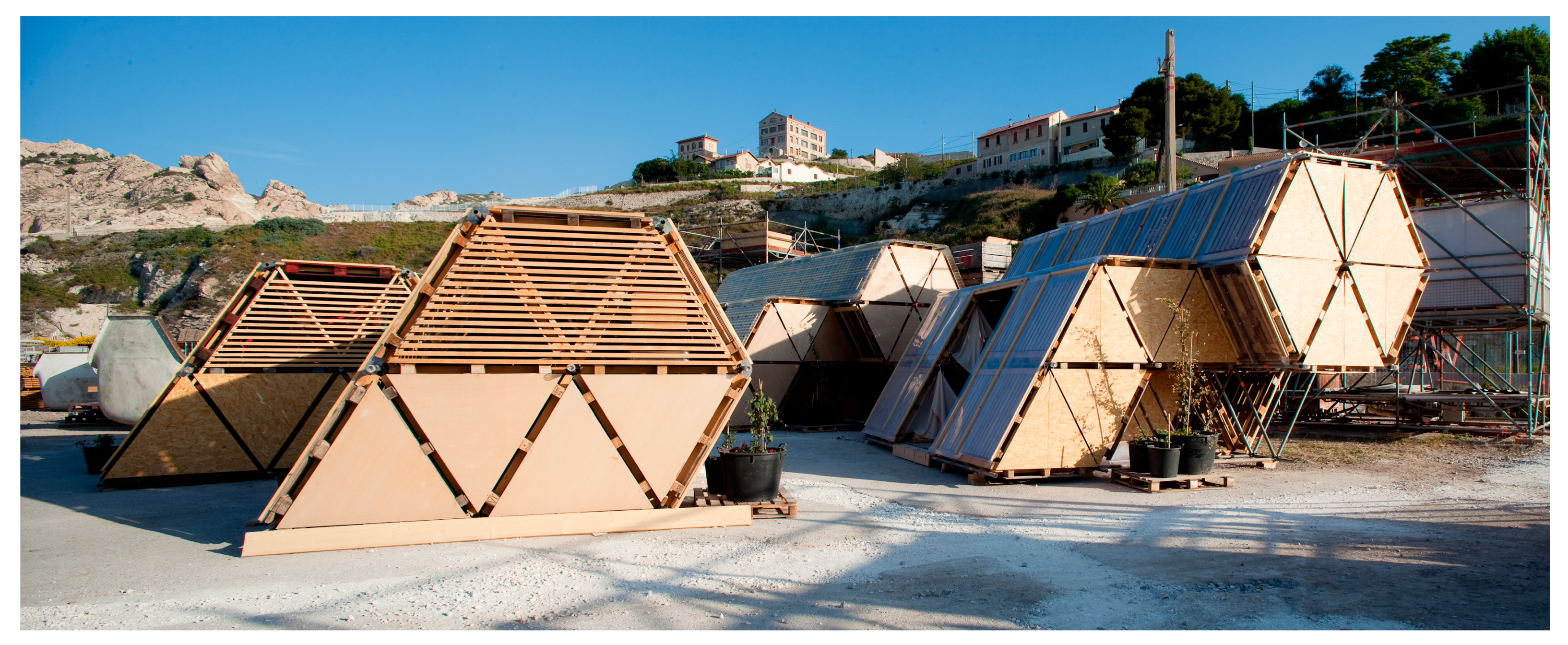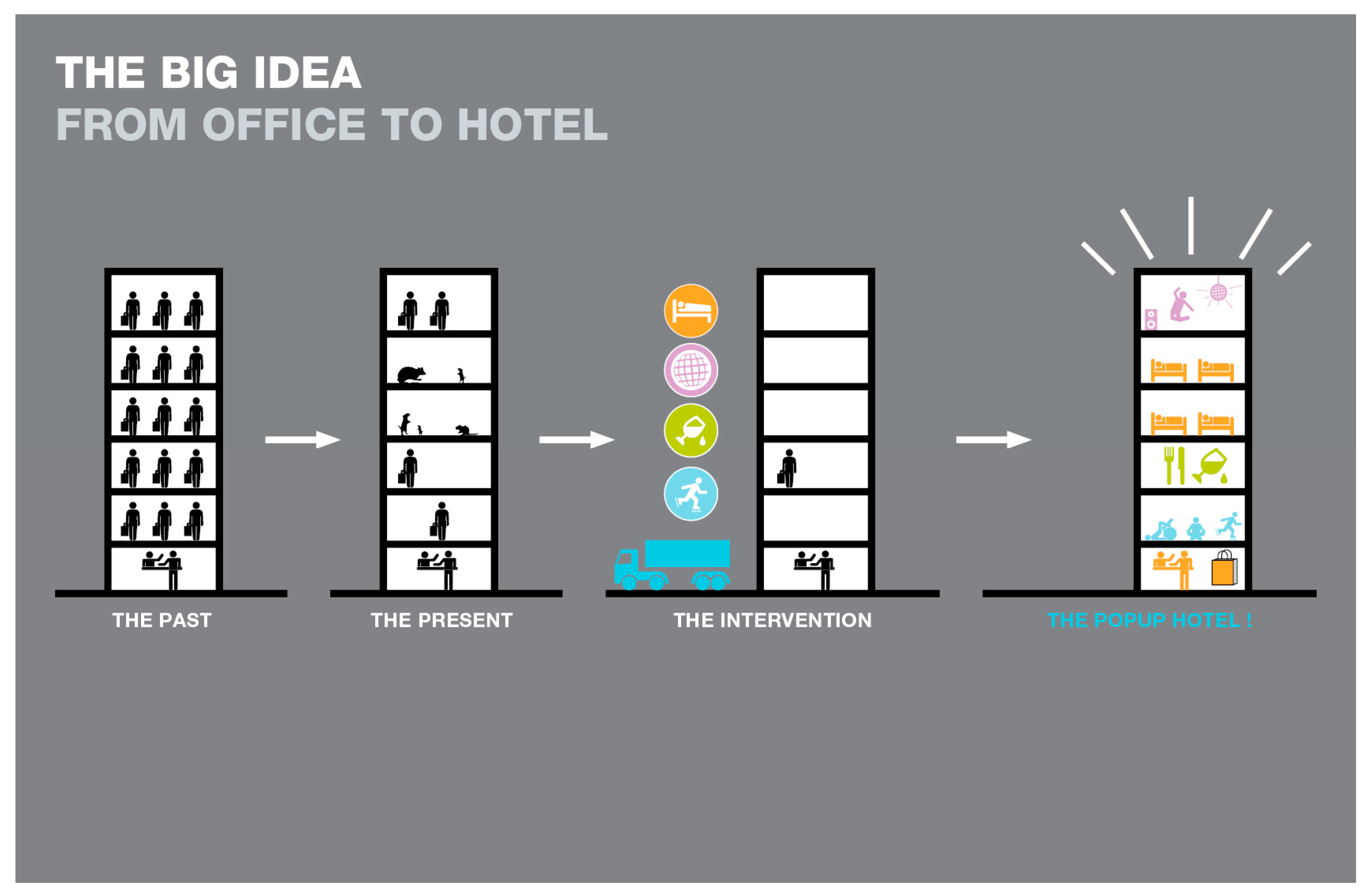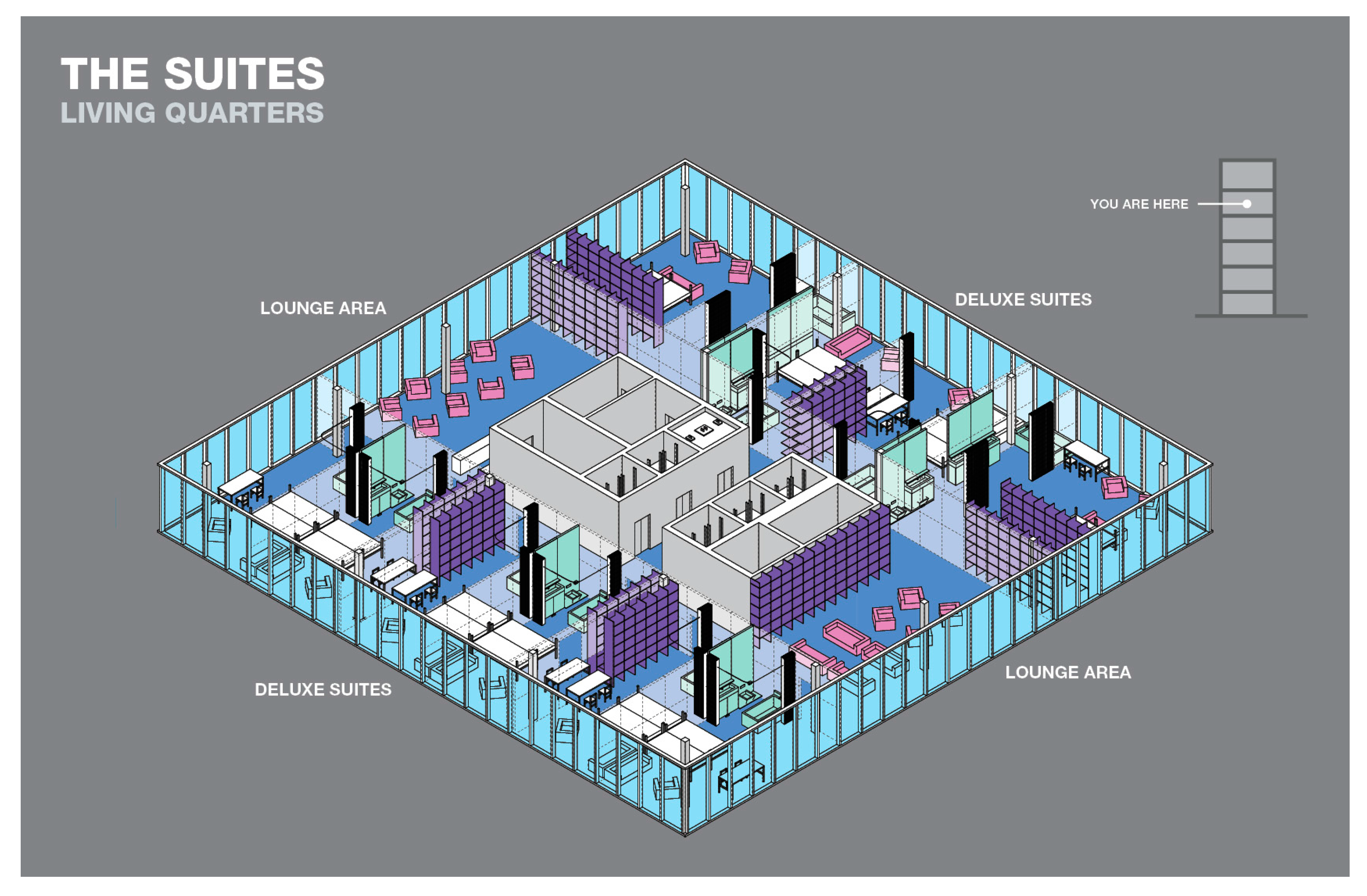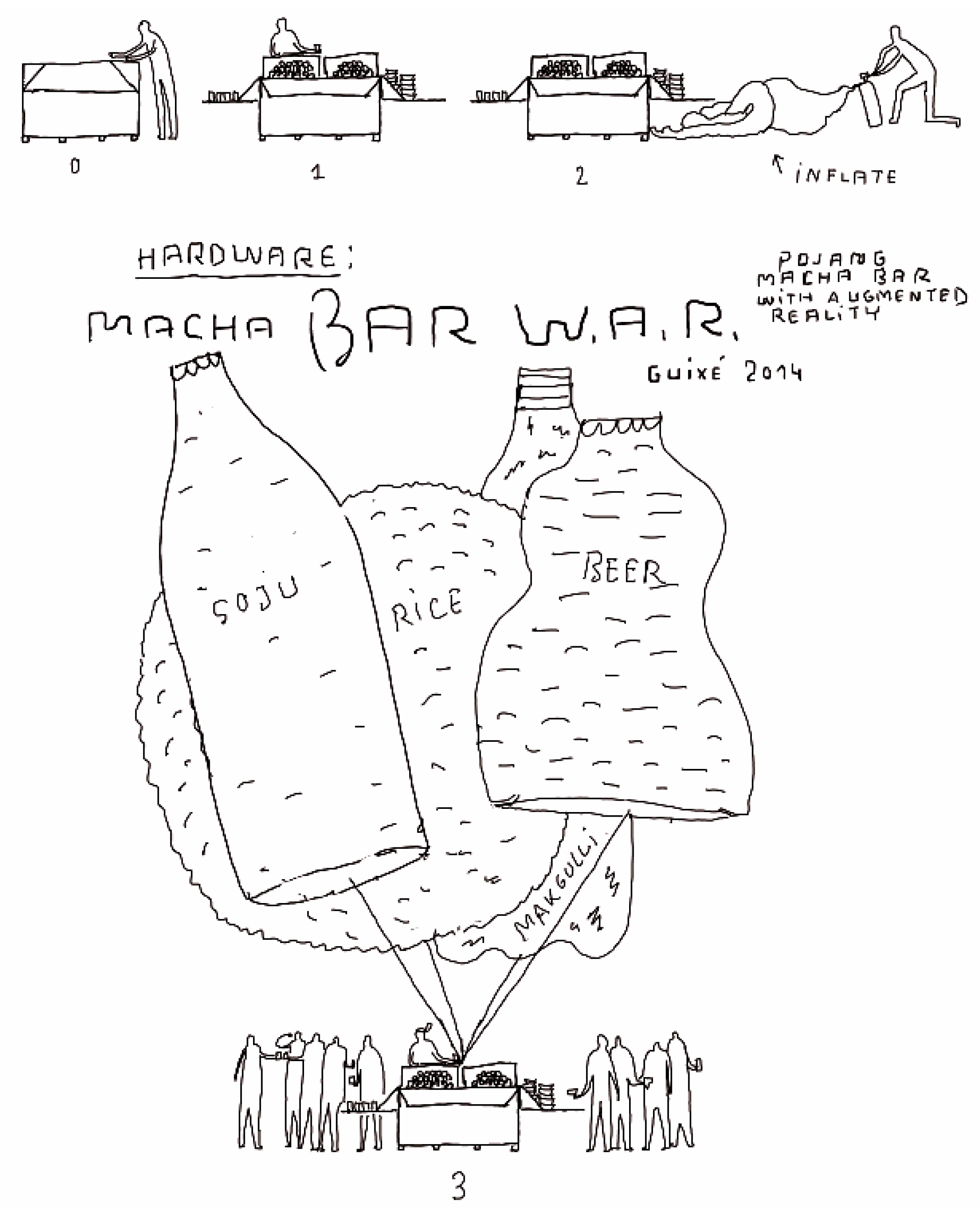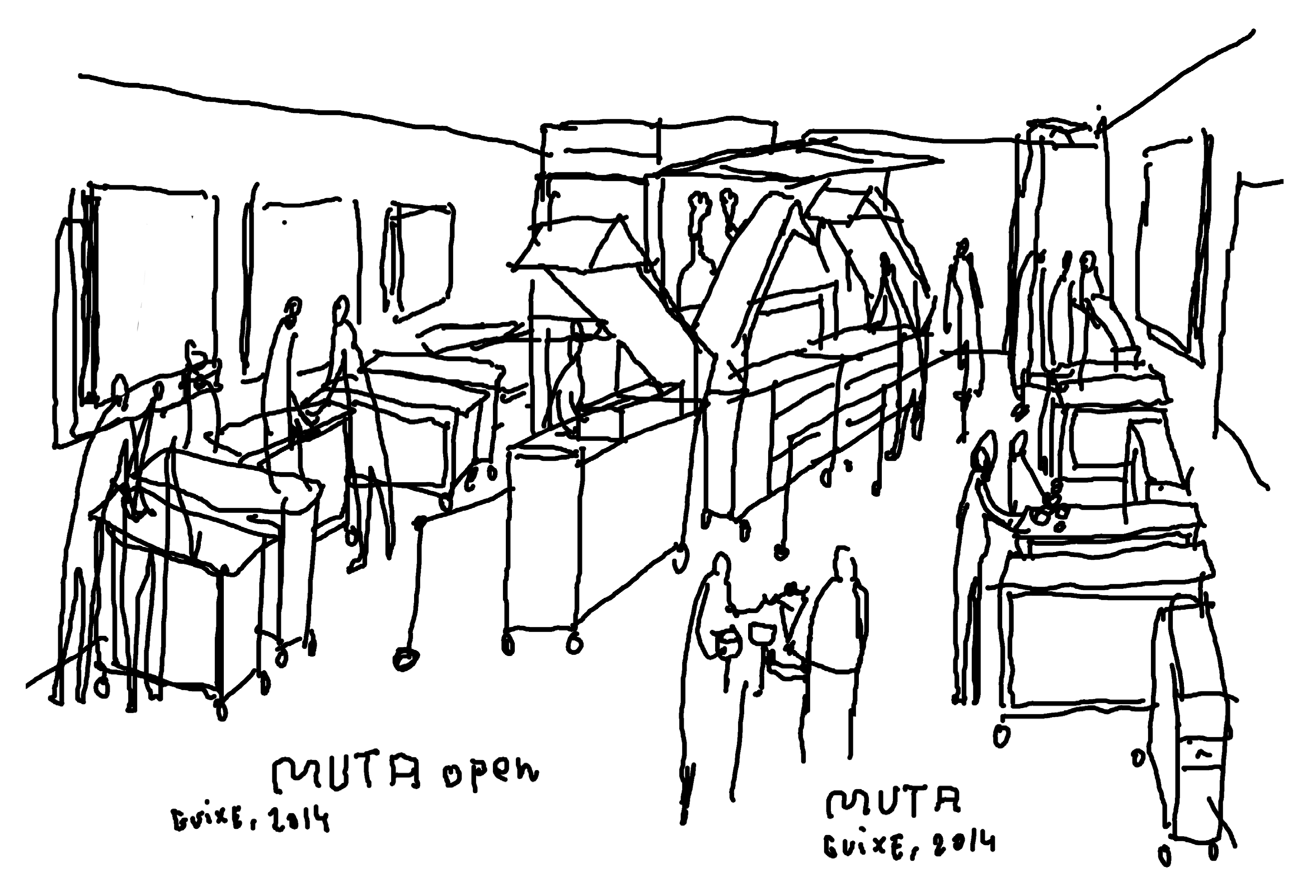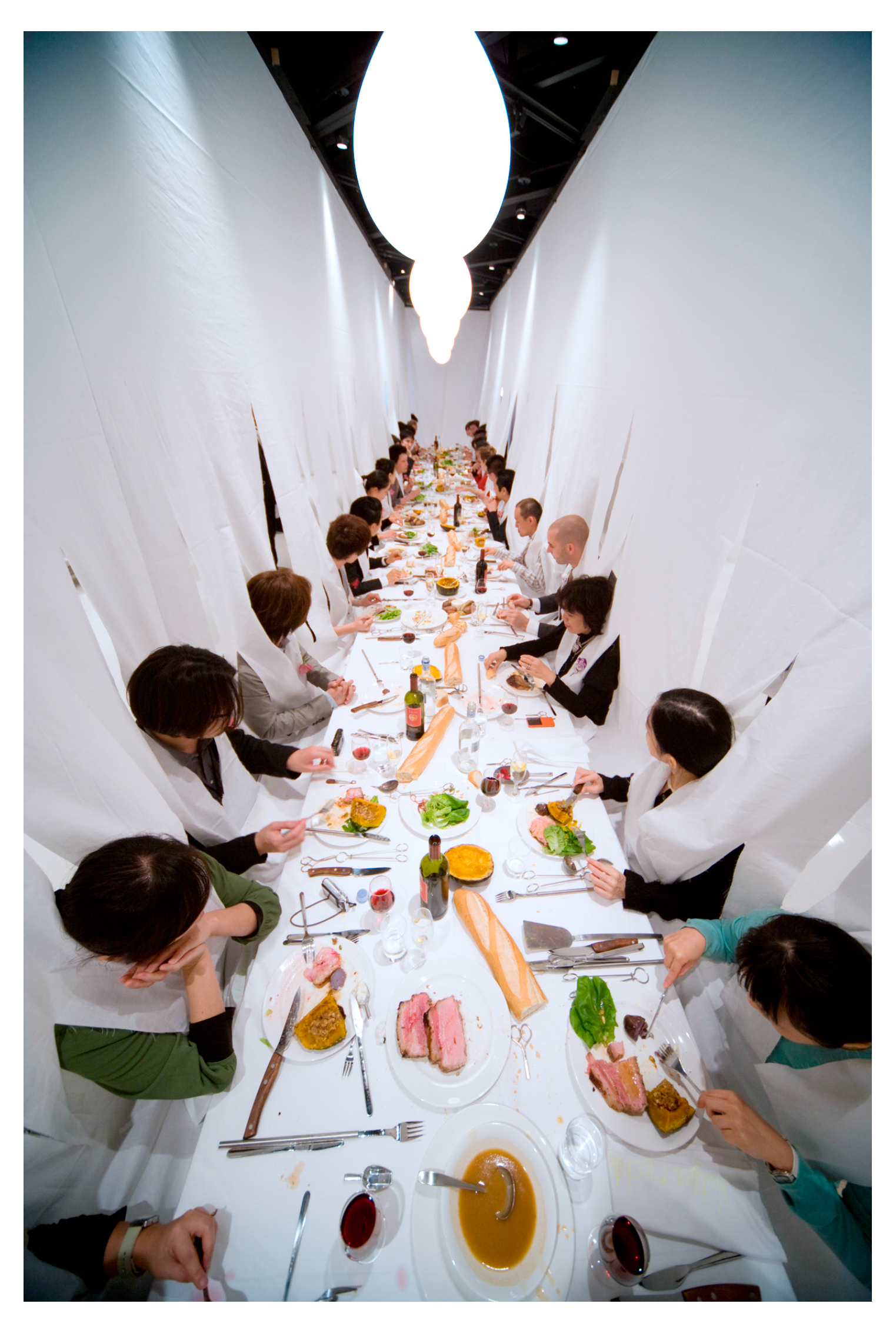2. Housing Facilities
Liquid architecture is particularly meaningful in some global ‘transient’ cities, especially in under-developed countries with a high turnover of temporary expat residents, where fast urban sprawl led to the proliferation of urban voids, fragments of land with no identity and no function. These voids can be temporarily filled and used by installing impermanent pop-up architectures, suitable to fulfill the temporary needs of a transient population, for a fixed period of time.
Many cities experimented with options such as pop-up shelters, discovering collapsible and reversible solutions as the experimentation field for the relational dynamics among temporary needs, the urban venue and its users (
Elgani 2014).
Open air spaces and disused buildings may become the setting for temporary projects to give a response to new generations of globetrotters, seeking real contact with the local context and sharing spaces, facilities and experiences.
Concerning these temporary accommodation needs, in recent years an important innovation has been the rise of new hospitality forms offered by the Internet and social networks. They have significantly increased the opportunities to communicate and interact among the travelers, allowing them to access information to organize a trip and to pinpoint a place to stay by comparing other people’s experiences (
Scullica 2014). Websites such as Tripadvisor (
https://www.tripadvisor.com/), apps, travel blogs and virtual communities broaden the “experiential menus” proposed to the various guests and encourage the creation of new hospitality forms standing outside the established system of accommodation models. Nowadays, sites such as Airbnb (
https://www.airbnb.com/), Couchsurfing (
https://www.couchsurfing.com/) or Campinmygarden (
https:// campinmygarden.com) are aiming to put potential users in contact to find accommodations in private homes or unusual locations. Couchsurfing, particularly, offers an exchange service of free accommodation and is, as well as Bed Sharing (
http://www.bedsharing.org) launched in 2007 for Design Week in Milan, a model of alternative hospitality that creates new opportunities for meeting people with a much deeper relational interaction between guests and hosts.
Hosting temporary visitors requires the town to have the capacity to adapt and respond to the demand for new, better public services and spaces. Facilities for accommodating visitors (meeting places, info-points, public transports and toilets) are essential in providing new qualities in sharing experiences and in the perception of the urban venue.
It is important to focus on the relevance of the experiential social component in designing new affordable hospitality typologies.
Installed in open spaces or in disused buildings, these temporary structures offer inexpensive solutions to accommodate an aware new generation of travelers, seeking real contact with the local context, also from a perspective of sharing spaces, services and personal experiences.
In these new dwelling models, beyond the basic service offered (accommodation), importance is also stressed on the experience given to the guest, providing solutions able to encourage interactions between people.
The short implementation times of these solutions allow visitors to be accommodated for limited periods in outdoor areas regained by the urban landscape or indoors, inside unused or underused buildings. These parts of the city, often forgotten by the local inhabitants, are reused, activating a perceptive change.
In Milan, this result has been achieved in recent years by the project Public Camping of 2011 for the Public Design Festival by Esterni (
Figure 1), taking place every year during Design Week. Set up in two different locations of the Lambrate zone, outdoors under a road bridge and indoors inside the building of the Lambretto Art Project, this temporary urban camping ground was equipped with a full list of facilities in order to enhance the guests’ experience, creating sharing opportunities, such as a relaxation and meeting area and an international library, an Internet point, a workstation, locker room, restrooms and toilets.
The materials used are light and, in some cases, recycled or reusable, to enable high levels of flexibility in shaping the spaces for rest and personal care and the collective spaces for meeting, eating and drinking. Once the event is over, the camping ground is dismantled, its components recycled and the space restored to its initial condition. Thus, this kind of accommodation represents a sustainable approach to temporary hospitality, significantly reducing the impact on the urban context.
Another interesting reference project is Hexa (hexagonal) Structures (
Figure 2), installed by the organization Yes We Camp! for the event Marseille European Capital of Culture 2013.
Locals and international visitors built this temporary urban camping ground in a joint architectural performance. Its modular, no-waste approach is an expression of the architecture of a new breed of urban nomads, providing sleeping and resting shelters while at the same time opening up new ways of public space re-appropriation.
The peculiarity of this project is that Hexa Structures are easy to build by non-skilled people, due to their standardized and optimized elements consisting of wooden pallets and steel scaffolding. Construction can be quick and is easily mounted using low-tech fastening techniques. In the proper conditions, a whole camping facility for hundreds of people can be built or dismantled in a very short time. Both activities are very energizing, bringing peers together, and creating a shared experience.
Furthermore, this venue is also a social space: it hosts the ever-changing, fluid, temporary inter-relational contacts created among people, whether traveling, constructing, resting or sleeping in the Hexa Structures. Thus, in this project the aesthetic aspect was not actually considered, as the beauty of the structures lies in the formal expression of the unconventional way of living of its temporary inhabitants.
Recently, an interesting and innovative proposal for a nomadic dwelling model was awarded the grand prize of the Annual Radical Innovation in Hospitality Award in 2013, an international competition that is acting as a catalyst for new ideas in hospitality design, challenging architects and the hotel industry to create innovative concepts.
The proposal concerns a project for a pop-up hotel aimed at turning empty office buildings in midtown Manhattan into temporary hospitality spaces, designed by the Copenhagen-based international architecture collective PinkCloud.dk (
Figure 3 and
Figure 4).
The project’s core idea came from the awareness that Manhattan’s midtown area was in a real estate crisis. High rents pushed tenants to move to their offices to cheaper areas in New Jersey. As a result, in midtown, office vacancies were high and their rents were plummeting. The whole area was standing in a stalemate condition of post-recession decline. The outdated building stock, the lasting effects of the economic recession and the lack of amenities in the neighborhood posed the urgent issue of the adaptive reuse of its built heritage.
On the other hand, the city of Manhattan is characterized by an all-year-long high request of accommodation, both for leisure, business or study reasons. Rentals are very expensive and often unaffordable to the new generations of young “millennials”.
The project’s idea is a pop-up hotel to be installed in the vacant venues, designed to be a means of urban revitalization, an economic catalyst, as well as an active community partner. The design concept intended to transform the overall building’s function involving temporary guests living in a new and unconventional dwelling model.
Vacant office buildings in midtown Manhattan are usually Class A energy-efficient spaces, organized as full open-space floors, in order to allow flexible workplace layout options.
According to the project proposal, the empty spaces of the underused buildings will be filled with the basic functions of hospitality, by means of a whole set of single-function installations.
Each main function has an identifying color and it is split into sub-functions. The basic functions, organized by a pop-up kit of parts, are the hotel (gathering guestrooms, nap area, concierge and lounge), the dining areas (a café/bakery, a cocktail bar, a restaurant and a wine bar), the entertainment areas (a nightclub, exhibition areas, workstations, and spaces for design-related events) and the amenities (shopping, fitness, spa, and function spaces for seminars, conferences, etc.).
Following a rational order, each macro-set of functions will find a place on a floor, characterizing the glazed transparent facades of the buildings with their identifying colors.
When the local demand for accommodation decreases, it can be uninstalled and moved to another location, elsewhere, where the demand justifies its presence.
For this reason, each piece of furniture and equipment has a modular standardized design, designed on purpose to be easily moved by trucks. The project provides a modular packaging system, with boxes dimensioned according to the U.S. standard pallet base (approximately 1.02×1.22× 0.15 m), with a height calibrated in order to fit into a normal elevator, pallet included (h = 2.40 m). A single truck will be able to carry 36 boxes at once. Boxes have different colors referring to their macro-functional content (dwelling, dining, entertainment and amenities). Each box is traceable through an ID sticker on the box. The color-coded boxes facilitate transportation and set-up, acting also, while transferred, as a distinctive marketing component.
Removable soundproof partitions will separate the different functional spaces in open-space floors, while the required additional plumbing will be hooked to the existing building plumbing and redirected to the new bath facilities. If necessary, additional external water pumps can be installed.
This kind of pop-up concept is flexible and adaptable to a wide range of unused buildings that are usually present in most cities: abandoned public and private buildings, dismissed industrial buildings, former schools, old cinemas, abandoned farms, railways stations in disuse, and so on.
A large number of built heritage sites can be exploited today with temporary functions, according to provisional local needs, allowing sustainable economic recovery from crisis periods. In this overall situation, pop-up settlements could assure an indoor shelter to many temporary inhabitants in many transient cities.
Besides the need for temporary dwelling, another fundamental necessity of humans, which has been a recent source of inspiration for a variety of pop-up installations, is the primordial need to be nourished.
3. Feeding Facilities
In today’s transient cities, architects and designers have experimented with many remarkable recent experiences of pop-up and temporary “feeding facilities”, installed or “performed” for special events and occasions. Festivals, concerts, commercial fairs and so on often need to cater large amounts of people for the whole duration of the event.
In addition, in recent times there has been an increasing cultural interest in the multiethnic theme of “street food”. This food market niche features a huge cultural variety and it is not yet well known by the mainstream public, nowadays drawing a lot of interest.
A creative designer of innovative pop-up food-based projects is the Spanish ex-designer Marti Guixé (
http://www.guixe.com/about/index.html). One of his most innovating concepts, performed in 2005 in Amsterdam, is the temporary pop-up restaurant Food Facility (
Aglieri Rinella 2014). This is a restaurant without a kitchen that completely outsources the food supply. The space layout (
Figure 5) is organized as a simple “place for food consumption”, with a wide hall of tables, where it is possible to order, by means of the Internet and smartphones, dishes that will be delivered at a central reception desk from the different restaurants with a delivery service in the surroundings, and then served at the clients’ table. This gastronomic platform allows connecting, in a cultural and social way, to the gastronomic urban context, in an always new and convivial experience. Food Facility can be implemented in different cultural and urban contexts, changing according to the case and to the needs and expectations of the single users. In this place, groups of people with different tastes and culinary needs (e.g., vegans, those with celiac disease, etc.) can sit around the same table in the same restaurant, ordering all different kinds of food, from pizza to sushi.
Guixé’s research on new opportunities for social unconventional food experiences is particularly intense, always proposing new flexible and adaptable pop-up models.
A subject of interest in Guixé’s world refers to pop-up stalls for street food. This includes an informal concept of food consumption that can be found with different scales and solutions in many of his projects. Already 10 years ago, with the project Camper Foodball, carried out in 2004 in Barcelona, he experimented with the reversal of meaning, turning the usual configuration of an external space into an interior (
Aglieri Rinella 2014, pp. 23–24).
In Camper Foodball, the space was divided into three basic zones: the entrance with the counter and cashier, the kitchen and the area for food consumption, designed with large terrace steps (like in front of a church in Mediterranean countries). Food is prepared in the form of stuffed small rice balls, and consumed in an informal way, sitting on the stairs, like in an open-air venue. The whole space is characterized as an unconventional place for contemporary users, and conceived as an “enclosed” urban space. There is no table service; food is purchased directly at the counter, where the offered food is actually “street food”.
Recently, Guixé also focused on concepts for movable and transportable pop-up bars and restaurants, which can be used both in indoor and outdoor locations.
The Macha Bar W.A.R. (With Augmented Reality) (
Figure 6) and MUTA (MUTAnt) (
Figure 7) bar-restaurant are two of these itinerant proposals, inspired by the Trojan Bar model, installed in Helsinki in 2012 and in Milan for Design Week in 2013 (in two different locations: inside Achille Castiglioni’s studio and at the Nike Stadium).
The Macha Bar W.A.R. has the shape of a wooden box that opens in a pop-up street food stall. The daily-changing menu provides a limited offering of two or three kinds of food and beverages, which are virtually represented as large inflatable balloons, hanging over the stall. These inflatable icons advertise the menu of the day, in an ironic representation of the virtual language, which is today flooding everyday life.
MUTA is another similar Guixé project for a “mutant” restaurant in Madrid; conceived as an unfinished space, the gastronomic offering periodically changes with foods and cooks coming from different countries. MUTA looks like a simple warehouse, underlining the mutable nature of “work in progress” of the concept. As a matter of fact, this restaurant has a mutant culinary offer, but also a mutant interior architecture: the pop-up boxes, placed inside the warehouse container space, allow a versatile adaptability according to different needs.
All these projects attempt to find new, flexible nomadic catering solutions, with collapsible installations that are easy to move and adapt to different cultural and spatial contexts.
Another interesting experience is the “eatertainment” installations designed by the “eating designer” Marije Vogelzang. Her design process is aimed at creating temporary environmental ‘performances’, focused on relational aesthetics and on the involvement of users in a collective ritual participation, which provide an amniotic interaction among food, man and the environment (
Aglieri Rinella 2015).
In this experimental field, her interesting work is based on sociality and on sharing human relations around food. For instance, Teardrop is a site-specific installation installed in the industrial space of DortYart, featuring three cylinders made of strings hanging from the ceiling, with a ring in the middle of glass drinking-straws. Pulling one of the strings, to which some labels containing fanciful sentences are attached, a drop of aromatized water falls into the mouth of the person standing under the ring in the center of the cylinder. The installation, with a strong visual impact, plays with childish emotions and with the playful action of being fed by somebody else.
Nevertheless, one of her most interesting projects was the “dining environment” known as Sharing Dinner, designed and performed in the Netherlands in 2005 for Droog Design and repeated in Tokyo in 2008 (
Figure 8). In this installation, Vogelzang emphasized the convivial dimension of the dining event, where the experience is achieved by dining all together around the table and sharing food. A special tablecloth was installed, hanging from the ceiling and creating a sort of cocoon, a scenery wrapping the environment in which participants accessed threading inside the head and arm, from proper small openings. The dinner performance was held inside this embryonic environment, where each element is intended to facilitate sharing and exchange: table companions are forced to exchange cutlery and courses, in a continuous interaction. At the end of the dinner, the event is concluded with the ‘final release’ of participants that cut the tablecloth using the scissors supplied with the cutlery.
All these different experiences, in conclusion, are based on two main common features: the temporality of the event (its transient nature) and the need to be moved and performed again elsewhere, according to new conditions. These aspects involve a different relationship with the physical context each time, and therefore these projects need to be flexible and adjustable and, as per the housing case previously discussed, they can be conceived as transitory ethereal architectures able to respond to the nourishing needs of a transient population.

